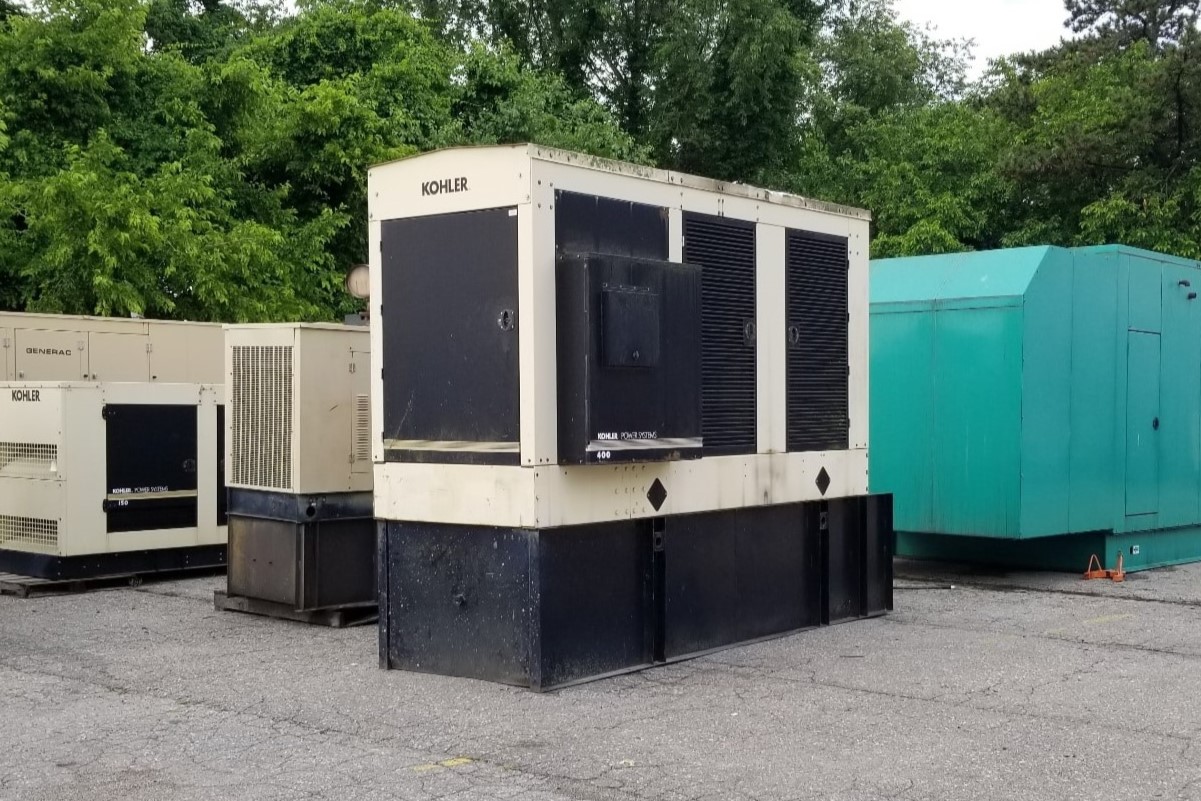Home>Maintenance & Safety>Emergency Preparedness>How Does A Backup Generator Work?


Emergency Preparedness
How Does A Backup Generator Work?
Modified: February 16, 2024
Learn how backup generators work to keep your home powered during emergencies. Discover the importance of emergency preparedness and how a generator can provide peace of mind.
(Many of the links in this article redirect to a specific reviewed product. Your purchase of these products through affiliate links helps to generate commission for Storables.com, at no extra cost. Learn more)
Introduction
In times of uncertainty and unforeseen circumstances, having a reliable source of backup power can be a game-changer. Whether it's a sudden power outage due to extreme weather conditions or an unexpected electrical failure, a backup generator can provide the reassurance and stability needed to navigate through such challenging situations. Understanding how backup generators function and the benefits they offer can empower individuals and communities to proactively prepare for emergencies and minimize disruptions.
A backup generator serves as a safeguard against the inconvenience and potential hazards associated with power loss. By seamlessly activating when the primary power source falters, these devices ensure that essential appliances, medical equipment, communication systems, and security measures remain operational. This capability not only fosters a sense of security but also enables individuals to maintain a semblance of normalcy during turbulent times.
In this comprehensive guide, we will delve into the intricacies of backup generators, exploring the various types available, the fundamental components that make up these systems, and the mechanisms through which they operate. Moreover, we will shed light on the myriad benefits that backup generators bring to the table, ultimately highlighting their indispensable role in bolstering preparedness and resilience.
Join us on this enlightening journey as we unravel the inner workings of backup generators, equipping you with the knowledge to make informed decisions about integrating these invaluable assets into your emergency preparedness strategy. Let's embark on this illuminating exploration of how backup generators work and the peace of mind they can bestow upon those who embrace their protective embrace.
Key Takeaways:
- Backup generators come in two types: portable and standby. Portable generators are for temporary use, while standby generators provide continuous power to an entire household or facility during outages.
- The key components of a backup generator include the engine, alternator, fuel system, voltage regulator, and control panel. These components work together to transform fuel into electrical power, ensuring essential appliances remain operational during outages.
Read more: How To Install A Backup Generator
Types of Backup Generators
Backup generators come in various types, each designed to cater to specific needs and circumstances. Understanding the distinctions between these types is crucial for selecting the most suitable option for your requirements. The two primary categories of backup generators are portable generators and standby generators.
- Portable Generators: These versatile generators are designed for temporary use and are typically fueled by gasoline or propane. They are well-suited for providing power to a few essential appliances or tools during short-term outages. Portable generators are compact, easy to transport, and can be a valuable asset for camping trips, outdoor events, or as a backup power source for residential needs.
- Standby Generators: Standby generators, also known as permanent or whole-house generators, are robust, fixed installations that are directly connected to a home or building's electrical system. They are powered by natural gas, propane, or diesel and are capable of automatically activating when a power outage is detected. Standby generators are designed to provide continuous, uninterrupted power to an entire household or facility, making them an ideal choice for long-term or frequent power disruptions.
Within these two primary categories, there are further distinctions based on power output capacity, fuel type, and specific features. Inverter generators, for instance, are a type of portable generator that offers cleaner and more stable power, making them suitable for sensitive electronic devices. On the other hand, standby generators can be categorized based on their power capacity, ranging from essential circuits models to whole-house generators with high kilowatt ratings.
By evaluating the duration and frequency of power outages, the power requirements of essential appliances, and the budget constraints, individuals and businesses can make informed decisions when choosing between portable and standby generators. Each type has its unique advantages and limitations, and understanding these nuances is pivotal in ensuring that the selected generator aligns with the specific needs and priorities of the user.
Now that we have explored the primary types of backup generators, let's delve deeper into the essential components that constitute these invaluable assets.
Components of a Backup Generator
Understanding the components of a backup generator is fundamental to grasping how these systems function and deliver reliable power during outages. While the specific components may vary based on the type and model of the generator, the fundamental elements remain consistent across most designs. The key components of a backup generator include the engine, alternator, fuel system, voltage regulator, and control panel.
- Engine: At the heart of every generator lies the engine, which is responsible for converting fuel into mechanical energy. The engine drives the alternator, initiating the generation of electricity to power connected devices and systems.
- Alternator: The alternator, also known as the generator head, is the component that converts the mechanical energy from the engine into electrical energy. It consists of a rotor and a stator, utilizing the principles of electromagnetic induction to produce the electrical output required to supply power to the connected load.
- Fuel System: The fuel system comprises the fuel tank, fuel pump, and fuel lines, facilitating the delivery of the generator’s fuel source to the engine. Depending on the type of generator, the fuel may be gasoline, diesel, natural gas, propane, or a combination of these options.
- Voltage Regulator: The voltage regulator plays a critical role in maintaining a steady and safe output voltage from the generator. It regulates the electrical output to ensure that the connected appliances and devices receive a consistent and reliable supply of power, protecting them from potential damage due to voltage fluctuations.
- Control Panel: The control panel serves as the command center of the generator, housing the start/stop controls, monitoring gauges, and safety features. It allows users to start and stop the generator, monitor vital parameters such as voltage and frequency, and provides essential safety mechanisms to protect the generator and connected systems.
These components work in harmony to transform fuel into electrical power, offering a lifeline during power outages and enabling individuals and businesses to maintain essential operations. Whether it’s a portable generator powering crucial appliances or a standby generator safeguarding an entire household, understanding the role of each component is pivotal in ensuring the reliable and efficient performance of the generator.
With a comprehensive understanding of the essential components of backup generators, we can now explore the intricate mechanisms through which these vital systems operate to deliver uninterrupted power when it is needed most.
A backup generator works by using an internal combustion engine to convert fuel, such as gasoline or natural gas, into electricity. This electricity is then used to power essential appliances and devices during a power outage. Regular maintenance and testing are important to ensure the generator is ready when needed.
How Backup Generators Work
Backup generators are designed to seamlessly provide electrical power when the primary grid supply is disrupted, ensuring that essential appliances and systems remain operational. The operation of backup generators involves a series of intricate processes that culminate in the generation and distribution of electrical power to the designated circuits or loads. Let’s explore the fundamental steps through which backup generators work to deliver reliable and uninterrupted power.
- Detection of Power Loss: When the primary power supply is interrupted, whether due to a grid failure or another triggering event, the backup generator’s automatic transfer switch (ATS) or controller detects the loss of power. This initiates the start-up sequence of the generator, preparing it to assume the role of the primary power source.
- Engine Start-Up: Upon receiving the signal to activate, the generator’s engine is started either by a battery or through a manual pull-start mechanism, depending on the type of generator. The engine begins to convert the stored energy in the fuel into mechanical energy, setting the stage for the generation of electrical power.
- Power Generation: As the engine runs, it drives the alternator, which, in turn, produces electrical power through the process of electromagnetic induction. The alternating current (AC) generated by the alternator is then converted to a usable form through the voltage regulator, ensuring that the output meets the required voltage and frequency standards.
- Transfer of Power: The generated electrical power is then channeled through the generator’s output connections to the designated circuits or the building’s electrical distribution panel. In the case of standby generators, the automatic transfer switch seamlessly redirects the electrical load from the grid to the generator, ensuring a smooth transition of power supply.
- Continuous Operation: The backup generator continues to operate, supplying electrical power to the connected loads until the primary grid supply is restored. Once grid power is reinstated, the automatic transfer switch switches the electrical load back to the primary supply, and the generator is then systematically shut down, ready to spring into action when the need arises again.
By meticulously executing these steps, backup generators fulfill their critical role in maintaining power continuity during outages, offering a reliable source of electricity to sustain vital functions. Whether it’s preserving the comfort and safety of a home or ensuring the uninterrupted operation of critical infrastructure, the seamless operation of backup generators is indispensable in mitigating the impact of power disruptions.
As we unravel the intricacies of how backup generators function, it becomes evident that their operation is a testament to engineering ingenuity and preparedness, empowering individuals and communities to navigate through challenging circumstances with resilience and confidence.
Benefits of Backup Generators
Backup generators offer a myriad of benefits that extend far beyond the provision of electrical power during outages. These invaluable assets play a pivotal role in safeguarding individuals, businesses, and communities, providing a sense of security and resilience in the face of unforeseen disruptions. Let’s explore the diverse array of benefits that backup generators bring to the table, underscoring their indispensable role in bolstering preparedness and continuity.
- Uninterrupted Power Supply: The primary benefit of backup generators is their ability to seamlessly provide electrical power during outages, ensuring that essential appliances, medical equipment, communication systems, and security measures remain operational. This uninterrupted power supply is particularly crucial for healthcare facilities, data centers, and residential settings, where consistent power is imperative for safety and well-being.
- Enhanced Safety and Security: Backup generators contribute to enhanced safety and security by preventing disruptions to critical systems such as lighting, surveillance cameras, alarm systems, and access controls. This is especially vital in emergency situations, where uninterrupted power can make a significant difference in ensuring the protection and well-being of individuals and assets.
- Preservation of Comfort and Livelihood: In residential settings, backup generators preserve the comfort and functionality of homes by powering heating and cooling systems, refrigerators, and other essential appliances. This not only maintains a comfortable living environment but also safeguards perishable food and medications from spoiling during prolonged outages.
- Business Continuity: For businesses and commercial establishments, backup generators are indispensable for maintaining operations, preserving productivity, and upholding customer service commitments during power disruptions. They mitigate the impact of outages on revenue, customer satisfaction, and the integrity of critical processes and equipment.
- Disaster Preparedness: Backup generators are integral to disaster preparedness, enabling individuals and organizations to proactively mitigate the impact of natural disasters, severe weather events, and unforeseen emergencies. By ensuring a reliable source of power, these generators contribute to resilience and the ability to swiftly recover from disruptions.
- Peace of Mind: Perhaps one of the most valuable benefits of backup generators is the peace of mind they bestow upon their users. Knowing that a dependable source of power is readily available in times of need alleviates anxiety and empowers individuals to face challenges with confidence and assurance.
These benefits collectively underscore the indispensable role of backup generators in fortifying preparedness, resilience, and continuity. Whether it’s mitigating the impact of outages on essential services, preserving safety and security, or upholding the fabric of daily life, backup generators stand as stalwart guardians, ready to step in and deliver the power needed to weather the storm.
As we reflect on the diverse benefits that backup generators offer, it becomes evident that their presence is not merely about electricity but about empowerment, protection, and the fortification of the human spirit in the face of adversity.
Read more: What Is The Best Backup Generator For Home
Conclusion
In the realm of emergency preparedness and resilience, backup generators emerge as stalwart guardians, offering a lifeline of electrical power during times of uncertainty and disruption. Through our exploration of the types, components, operation, and benefits of backup generators, we have gained a profound understanding of their indispensable role in fortifying preparedness and continuity.
From portable generators providing temporary power solutions to standby generators seamlessly safeguarding entire households and facilities, the diverse types of backup generators cater to a spectrum of needs, empowering individuals and businesses to navigate through outages with confidence.
The fundamental components of backup generators, including the engine, alternator, fuel system, voltage regulator, and control panel, work in harmony to transform fuel into electrical power, ensuring that essential appliances and systems remain operational when the primary grid supply falters.
The intricate mechanisms through which backup generators operate, from the detection of power loss to the seamless transfer of electrical load, exemplify the engineering ingenuity and preparedness that underpin these vital systems. By meticulously executing these processes, backup generators deliver reliable and uninterrupted power, preserving safety, security, and comfort in the face of adversity.
Moreover, the diverse array of benefits that backup generators offer, from uninterrupted power supply and enhanced safety to business continuity and peace of mind, underscores their pivotal role in fortifying resilience and mitigating the impact of outages on individuals, businesses, and communities.
As we conclude this enlightening journey through the realm of backup generators, it becomes apparent that these invaluable assets are not merely about electricity but about empowerment, protection, and the fortification of the human spirit in the face of adversity. They stand as beacons of reliability, ready to illuminate the path forward and serve as a testament to the resilience and ingenuity of the human spirit.
Let us embrace the knowledge and insights gained from this exploration, empowering ourselves and those around us to proactively prepare for the unexpected and to stand unwavering in the face of challenges, fortified by the protective embrace of backup generators.
Frequently Asked Questions about How Does A Backup Generator Work?
Was this page helpful?
At Storables.com, we guarantee accurate and reliable information. Our content, validated by Expert Board Contributors, is crafted following stringent Editorial Policies. We're committed to providing you with well-researched, expert-backed insights for all your informational needs.















0 thoughts on “How Does A Backup Generator Work?”